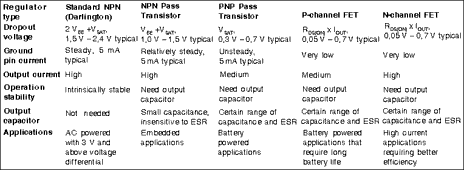
The pass element used in a linear regulator establishes the dropout voltage and ground current which, in turn, determine the types of applications for which the regulator is suitable. Each of the five main linear regulators used today has a different pass element and unique characteristics that make it ideal, or not so ideal, for certain applications.

Standard NPN regulator
Take, for example, the standard NPN regulator which uses a PNP transistor (Q1) and an NPN Darlington transistor pair (Q2 and Q3) as its pass element. Its dropout voltage is typically between 1,8 V and 2,4 V, given by:
VDROP = VSAT (Q1) + VBE (Q2) + VBE (Q3)
The advantages of the standard NPN regulator are:
* Steady ground current roughly equal to the base current of the PNP transistor (the load current divided by the gain of the pass element). The ground current is typically several mA.
* Unconditional stability without an output capacitor, because its pass element resembles a common collector configuration with very low output impedance.
Standard NPN regulators are useful in applications where the input-to-output voltage differential is high. However, its high dropout voltage makes it undesirable for many embedded applications.
NPN pass transistor regulator
The NPN pass transistor regulator uses a PNP transistor (Q1) and an NPN transistor (Q2) as its pass element. The dropout voltage is typically between 1,0 V and 1,5 V, given by:
VDROP = VSAT (Q1) + VBE (Q2)
The NPN pass transistor regulator has the following characteristics:
* High gain NPN pass transistor resulting in a steady ground current of typically several mA.
* It is in a common collector configuration with low output impedance, but nonetheless higher than that of the standard NPN regulator. Therefore, it requires an output capacitor with low capacitance for stability. The capacitor's equivalent series resistance (ESR) is not critical.
The NPN pass transistor regulator is useful in many embedded applications because of its lower dropout voltage and ease-of-use. However, it does not have a low enough dropout voltage for battery-powered applications with lower voltage differential budgets.
PNP pass transistor regulator
The PNP pass transistor is a low dropout regulator (LDO) with a PNP transistor (Q1) as its pass element. Its dropout voltage is usually between 0,3 V and 0,7 V, given by:
VDROP = VSAT (Q1)
The PNP pass transistor regulator has the following disadvantages:
* Its PNP transistor has low gain, resulting in unsteady ground current of typically several mA.
* Its high output impedance, due to its common emitter configuration, means that an output capacitor within a certain range of capacitance and ESR is required for stability.
Because of its low dropout voltage, the PNP pass transistor regulator is useful for battery-powered embedded applications. However, its high ground current shortens battery life.
P-channel FET regulator
The P-channel FET regulator uses a P-channel FET (Q1) as its pass element. Its dropout voltage is given by:
VDROP = RDS(ON) (Q1) x IOUT
Where RDS(ON) (Q1) is the drain-to-source resistance of the FET when fully on, and IOUT is the output current. The P-channel FET regulator's dropout voltage is low, because the RDS(ON) is easily adjusted to a low value by sizing the FET.
The P-channel FET regulator has the following characteristics:
* Low ground current because of the low gate current of the P-channel FET.
* The relatively high gate capacitance of the P-channel FET means that it requires an output capacitor with a certain range of capacitance and ESR for stability.
Because of its low dropout voltage and ground current, the P-channel FET regulator is popular for many of today's battery powered devices.
N-channel FET regulator
The N-channel FET regulator uses an N-channel FET (Q1) as its pass element, with its dropout voltage given by:
VDROP = RDS(ON) (Q1) x IOUT
The N-channel FET regulator's dropout voltage and ground current are low and it requires an output capacitor for stability, but the capacitance can be low, and the ESR is not critical. A charger pump is required to establish the gate bias voltage, resulting in more complex circuitry, however N-channel FETs are up to 50% smaller than P-channel FETs with the same load current.
N-channel FET regulators are ideal for applications that require low dropout voltage, low ground current and high load current.
Conclusion
Each type of linear regulator offers different advantages and disadvantages. Ultimately, it is the designer who must determine whether a certain type of linear regulator is appropriate for each application based on dropout voltage, ground current and stability compensation requirements.

© Technews Publishing (Pty) Ltd | All Rights Reserved